As soon as we stepped out of our minibus, the man appeared. He had wild black hair and piercing eyes and held out his hand as he waited impatiently for payment. With a fist full of dollars, he set off along an overgrown path into the jungle. We followed. After a short but sweaty walk uphill, we arrived at a small cave. A large artillery gun pointed towards the sea, supported on a wall of rusty drums. The Japanese gun is one of the few tourist attractions on Weno island, the capital of Chuuk State.

The Japanese Gun
The Chuukese Caveman's Home
During World War II, the Japanese used the networks of caves in Chuuk to store supplies and munitions. We came across another such cave a little further along the hillside. A small fire and cooking pot were assembled just outside the cave and the same man who had taken our payment was there to welcome us to his home. Inside, there was no furniture as such, just a modest sleeping area, washing line and a calendar hanging on the wall.
The man pulled aside the washing on the line revealing a small hole in the wall. Walking through, we stepped gingerly over piles of rubbish, plastic and broken glass as we made our way further into the cave system. The deeper we went, the more microbats buzzed past us, disturbed by the noise and torchlight. There wasn't actually much to see in the caves though so we retraced our steps back to daylight.

Bunker By The Caves
The Japanese Occupation Of Chuuk
After World War I, the Japanese acquired Chuuk and used it as a base in World War II. Airstrips were built, along with a hospital, a submarine base and a seaplane base, which is now the Blue Lagoon Resort. A large part of the Japanese Imperial Fleet was also stationed here, protected within the natural harbour of Chuuk Lagoon. In February 1944, Operation Hailstone, a 3-day aerial attack by the US, completely destroyed the Japanese fleet. Many cargo ships and smaller warships were wrecked here turning Chuuk into a world-renowned diving destination.
Find out more about life and death on the wrecks of Chuuk Lagoon.
Xavier High School
The main points of interest on Weno are relics of the Japanese occupation and military base. Our next stop was Xavier High School, a Jesuit mission school that was previously a Japanese communications centre.
The military history became apparent as soon as we walked through the studded metal door. Several inches thick, it is now painted a cheerful red. Passing kids playing in the gym, we stopped to look at a large hole in the ceiling. This bomb hole has never been repaired and is still a mess of broken concrete and twisted rebar. We also saw bright murals painted on the walls of the school. They gave a somewhat graphic depiction of wartime Chuuk, complete with bombers, warships and dying soldiers.
We climbed a narrow staircase leading to the roof for a birds-eye view of the whole school complex. Looking out across the gardens, we had a clear view to the island-studded sea beyond. The shallow corals reefs were visible as pale turquoise ribbons fringing both sides of the peninsula.
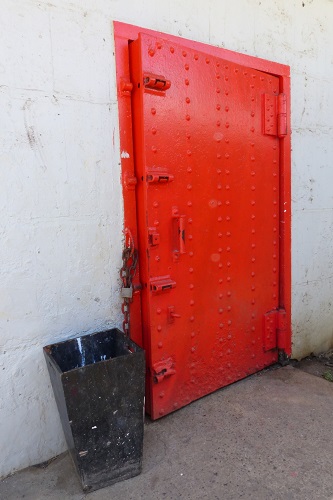
School Door
Getting To Chuuk's Main Town
Much of the main coastal road around Weno is little more than a dirt track and we bumped along, dodging floods as we went. With a loud crunch, we bottomed out on a particularly deep pothole. The door bore the brunt of the impact and wouldn't open when we got to our next stop. It took some acrobatics from our driver to get into the back of the minibus where a hefty kick was enough to fix the door.
The main town on Weno is a small settlement but surprisingly still ranks as the largest city in Micronesia. There are kiosks, restaurants, general stores and banks. There is an abundance of churches too, a reflection of the religious culture on the island. However, despite being well supplied with amenities, Chuuk is very remote so resources are limited and the facilities in town can't be relied on.
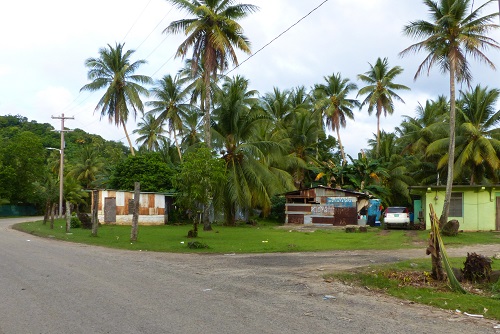
Houses On Weno
There are various relics from the Japanese occupation of Chuuk on Weno. The most popular are the Japanese gun and the communications centre that is now Xavier High School. It is also possible to arrange a visit to the neighbouring island of Tonowas, the centre of the Japanese operations. However it is the diving in Chuuk Lagoon that is the main attraction, which should not be missed.
Rain On Chuuk
As you may guess from the lush green forests on Chuuk, it rains a lot. The roads are not in good condition and become more treacherous when wet. Tours on both Weno and Tonowas may be cancelled if it rains.
What To Eat In Chuuk
Since Weno is a small island with little flat land suitable for agriculture, it's no surprise that most food is imported. We found local dishes to be the best options and the seafood was exceptional.
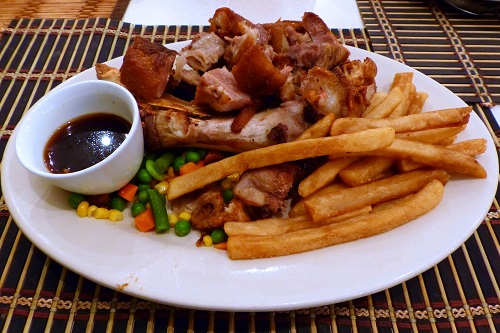
Crispy Pata
Reef fish like mahi mahi and parrotfish may be served fried or grilled. The whole fish certainly looks impressive but if you want to avoid the fiddly task of removing bones, opt for a fillet instead. Kare Kare, oxtail and pork knuckle stewed in a satay stock, is a hearty and filling meal. And if you're not so worried about your health, the Crispy Pata, deep fried pork knuckle, is worth trying. The meat is fatty, salty and delicious while the soy sauce and vinegar dip cuts through the grease and adds to the flavour.
Drinking from a fresh coconut will certainly make you feel like you're on holiday. However, don't expect this luxury on rainy days when climbing the trees to harvest coconuts becomes too risky.
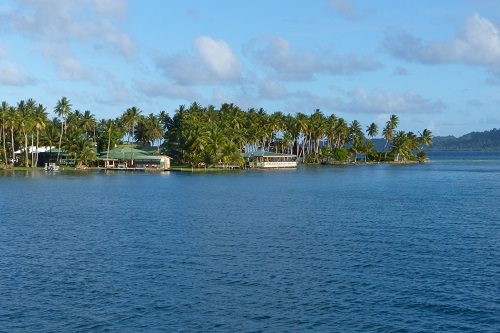
Blue Lagoon Resort
Where To Stay On Weno
There are two main accommodation options on Weno. The Blue Lagoon Resort is a relaxing place with large gardens full of coconut palms. The Truk Stop is smaller but nearer the town centre with easy access to local amenities. Both can arrange a tour of the historical highlights on land and both have dive centres on site.
How to get to Chuuk
Flights to Chuuk are very limited and only operate around 3 times a week.
1. Fly to Tokyo, Osaka, Seoul or Manila.
2. Take a United Airlines flight to Guam and from there on to Chuuk.
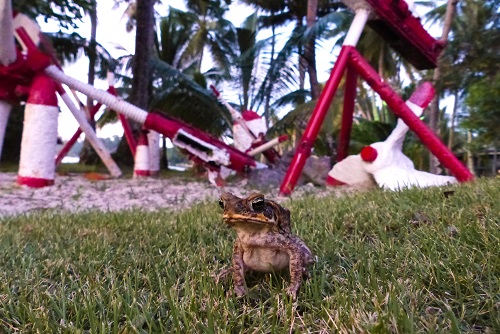
Toad
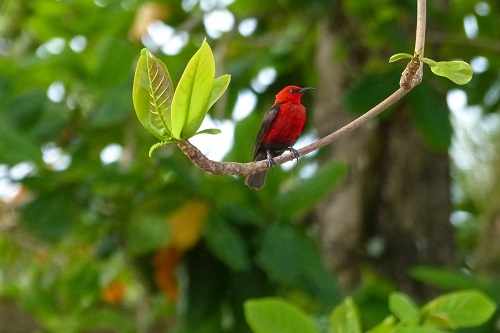
Micronesian Myzomela
Many thanks to the Blue Lagoon Resort for their generous hospitality. We loved the abundance of nature in the resort's gardens with striking red Micronesian Myzomelas darting between the trees and Ruddy Turnstones pecking around on the lawns. At dusk the gardens came alive with toads, gekkos, flying foxes and microbats, the perfect accompaniment to sunset drinks in the open-air bar.
